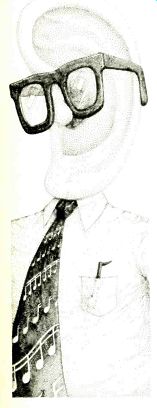The Middle-Aged Ear
Do the aural limitations of the high fidelity establishment compromise half the world's audio? by Robert Long There is a nice comfortable feeling in being assured that a piece of stereo gear will do only good things "from 20 Hz to 20 kHz." That, we all know, constitutes the total audible range; whatever happens at other frequencies is therefore inaudible and unimportant. Of course there are effects--like signal intermodulation with ultrasonics or infrasonic preamp overload--that degrade the audible signal due to something that's happening outside the band; but it's still only the audio-band by-products that we need be concerned with, either in listening or in testing.

Some recent investigation has suggested that-at the high end, at least-this range gives us more than we really need. Specifically, European "tonmeisters," the professionally trained sound specialists who run major Continental recording sessions, have been studying digital recording systems. Some had assumed that any system with a cutoff lower than 20 kHz would compromise sound quality. But in listening tests it frequently turned out that no difference could be perceived between a 20-kHz low-pass filter and one at 15 kHz; sometimes, indeed, the more restricted range was judged sonically superior.
Such findings can be viewed with pleasure by proponents of digital recording, the sampling frequency for which must be at least twice that of the highest tone it samples if the former is not to interfere with the latter. A top recorded frequency of 20 kHz thus requires a sampling rate of at least 40 kHz, while the sampling rate can be as low as 30 kHz (at considerable saving in tape and digital circuitry) if nothing above 15 kHz need be preserved in the audio. The tonmeisters, it seems, had feared that audio might need even more headroom--say, to 30 kHz, requiring a sampling rate of at least 60 kHz-if ultimate fidelity is to be maintained.
The fear is not unreasonable. There is plenty of other evidence that human hearing can, in fact, extend well beyond that magic 20 kHz. It has been known for a long time that the effective high-frequency cutoff for any given listener tends to creep downward with age and that the cutoff for the average man is lower than that for the average woman of the same age. Many now ensconced in the 20-to-20k audio industry (including me) have their own tales of "astonishing" youthful abilities--now vanished-to hear "ultrasonic" noises of which their elders were oblivious. One recent series of experiments suggests that most women can hear 30 kHz (or possibly higher) at age thirty and that most teenagers of both sexes can perceive frequencies above 30 kHz.
The audio establishment, however, is almost exclusively male and predominantly middle-aged. (I blink as I write, aware that, like it or not, I'm a middle-aged male member of the audio establishment.) "Good" hearing in a person of this description is generally accounted to go a little past 15 kHz and therefore to exceed averages for that gender and age group by a fairly small margin. How many tonmeisters, I wonder, can hear sounds close to 20 kHz? And should their judgment-or mine, or that of my colleagues on other consumer audio magazines--be allowed to circumscribe the sounds available to listeners who can hear 25 or 30 kHz? Is the audio establishment an oligarchy whose standards are imposed on the multitude without appeal and without redress? Consider the demographics. In round numbers, there are a little more than 200 million people in this country. Of the males, the number who are twenty years old or less is something a bit shy of 40 million; some 60 million females are thirty or less.
That's a total of 100 million Americans-roughly half the population-that might reasonably be expected to enjoy significantly more extended high-frequency hearing than middle-aged males.
For some months now, I've been seeking out expert opinion on this matter. Some of those to whom I talked (again, middle-aged males) flatly refuse to believe that hearing extends significantly beyond 20 kHz. One (elderly male) audio-metrist considers all hearing above 7 kHz as non-information-bearing and therefore academic. An equipment manufacturer dismissed the subject with the comment, "You mean kids; they're not my market." But those who ao take my questions seriously seem to have an answer. One European engineer put it this way:
"You're talking about the perception of individual tones. Yes, the ability to hear beyond 20 kHz is quite common, especially in teenagers and young adults. But when those tones are combined with lower ones in proportions that approach the balance of normal program material, the upper tones are masked and can no longer be perceived. A good deal of work has been done in Europe to investigate this area, and it demonstrates that nothing is to be gained by extending response beyond 20 kHz."
I hope he's right.
HF
(High Fidelity, Oct. 1979)
Also see:
Jensen speakers (ad, May 1981)
Empire's EDR.9 phono cartridge